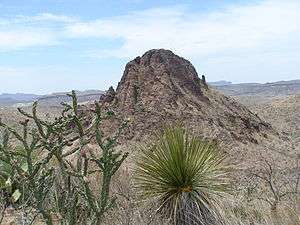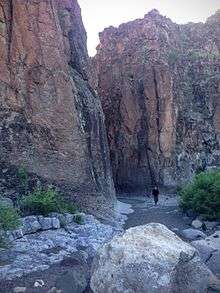Big Bend Ranch State Park
Big Bend Ranch State Park is a 311,000-acre (126,000 ha) state park located on the Rio Grande in Brewster and Presidio counties, Texas. It is the largest state park in Texas. The closest major town is Presidio, Texas, where the state park's head office is located.[1]
| Big Bend Ranch | |
|---|---|
 Solitario Peak (4786 ft), a prominent geologic feature of The Solitario, a collapsed laccolith | |
 Big Bend Ranch | |
| Location | Presidio / Brewster counties |
| Nearest town | Presidio, Texas |
| Coordinates | 29°31′50″N 104°09′16″W |
| Area | 311,000 acres (125,857 ha) |
| Established | 1988 |
| Governing body | Texas Parks and Wildlife |
| Website | Texas Parks and Wildlife |
Features

Big Bend Ranch is located adjacent to Big Bend National Park and shares the national park's Chihuahuan Desert ecosystem. However, in one significant aspect the state park is managed very differently from the nearby national park, as the state park encompasses a network of cattle ranches operated according to the principle of the open range. A herd of longhorn cattle is based here, and there is a semi-annual longhorn roundup.[2]
The Big Bend Ranch manages 23 miles (37 km) of frontage along the Rio Grande, and river rafting is popular here. Away from the river, visitors can hike, backpack, go horseback riding or enjoy mountain biking in the Big Bend Ranch's substantial backcountry. The park is open year round and an admission fee is charged.[1]
Flora
Desert vegetation dominates the park including lechuguilla and grama. Other common plants include sotol, ocotillo and mesquite. Along the Rio Grande and around some of the springs in the park are reeds, willows, and cottonwood and ash trees.[3] The park contains most of the existing populations of the federally threatened Hinckley oak.[4]
Fauna
Common animals in the park include gray fox, desert cottontail, two species of raven, mule deer, coyote, seven species of owl, kangaroo rat, six species of woodpecker, greater roadrunner, two species of vulture, jackrabbit, collared peccary and many species of lizard. Rarer animals include the cougar, golden eagle, bobcat, peregrine falcon, zone-tailed hawk and western mastiff bat.[3] As of 2011, park management is attempting to re-establish a self-sustaining population of desert bighorn sheep.[5]
Waterfalls
The Big Bend Ranch is home to Madrid Falls, the second highest waterfall in Texas. The terrain around Madrid Falls makes it difficult to access.[6]
Park management
Visitation
Big Bend Ranch State Park was expected to enjoy an estimated 2,500 visitors in 2008, a relatively low level of visitation for a park of its size.[7]
Activities
A number of companies in the area offer tours of the Rio Grande River, with most being based out of Terlingua, Texas. They offer guided rafting trips, canoe trips, guided hikes and backroad tours that are structured to provide education about the region's history, geology, wildlife and plant life.
Recent events
The Nature Conservancy of Texas announced in November 2008 that they had purchased the Fresno Ranch, a 7,000-acre (2,800 ha) inholding within the state park, for the purpose of planning the transfer of the land to the state park for integrated park management purposes and eventual public enjoyment. The price was said to be $2.6 million. The ranch, which occupied several comparatively well-watered parcels of land within the park's boundaries, was in the southeastern quadrant of the park.[7]
In early 2011, the Texas Parks and Wildlife Department oversaw the transport of 29 desert bighorn sheep to the Bofecillos Range. It was hoped that this herd would become the ancestral animals of a self-sustaining population of bighorns within the park. The last unmanaged population of Texas desert bighorn sheep was shot or died about 1958.[5]
See also
| Wikimedia Commons has media related to Big Bend Ranch State Park. |
References
- "Big Bend Ranch State Park", Texas Parks and Wildlife Department. Retrieved November 5, 2008.
- "Texas Longhorns in State Parks", Texas Parks and Wildlife Department. Retrieved November 5, 2008.
- Parent, Laurence. Official Guide to Texas State Parks. University of Texas Press, Fourth Edition, 2005. pp 8-11.
- Quercus hinckleyi. Archived 2011-10-26 at the Wayback Machine Center for Plant Conservation.
- "Local Outdoors for 7/22", San Marcos Daily Record, 2011-07-23. Archived 2011-09-27 at the Wayback Machine Retrieved August 2, 2011.
- "Big Bend's Madrid Falls are a rare sight", The Dallas Morning News' Retrieved February 10th, 2010.
- "Big Bend state park expands boundaries". Houston Chronicle. 2008-11-23.